Wildflowers of the Adirondacks:
Spreading Dogbane (Apocynum androsaemifolium)
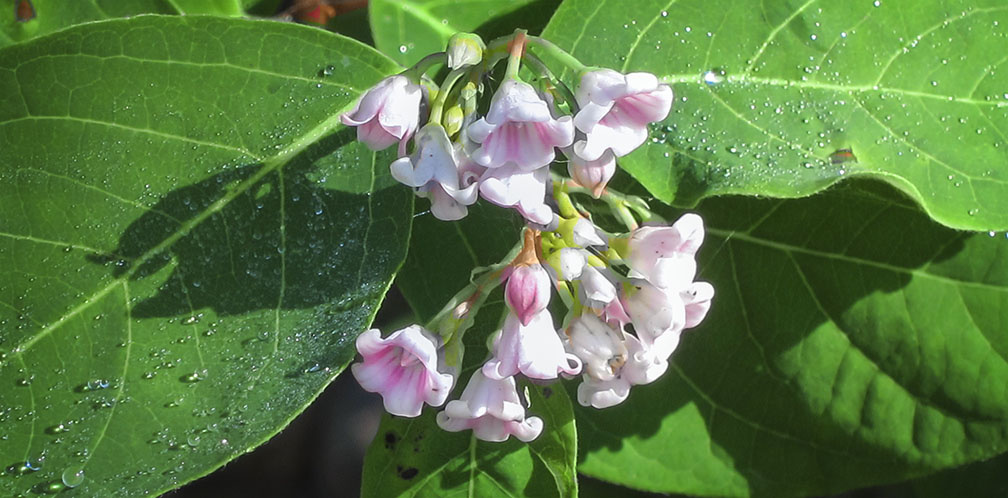
Spreading Dogbane (Apocynum androsaemifolium) is an Adirondack wildflower which sports clusters of fragrant, bell-shaped pink flowers from mid-June to mid-August. It is a member of the Dogbane (Apocynum) family. Spreading Dogbane is one of three species of Apocynum that occur in the Adirondacks. The others are Hybrid Dogbane (Apocynum androsaemifolium × A. cannabinum = A. ×floribundum) and Indian Hemp (Apocynum cannabinum).
Both the genus name and the plant's common names are references to the toxic nature of the plant, if eaten by dogs (or other mammals).
- According to several accounts, the genus name (Apocynum) is derived from Greek and means "away from dog."
- The most frequently-used common name for the plant is Spreading Dogbane. The first word is a reference to the fact that the plant tends to spread from underground rhizomes and form distinct patches.
- Other common names include Flytrap Dogbane and Bitterroot.
Although Spreading Dogbane is native to North America, it is considered a nuisance weed in some areas.
Identification of Spreading Dogbane
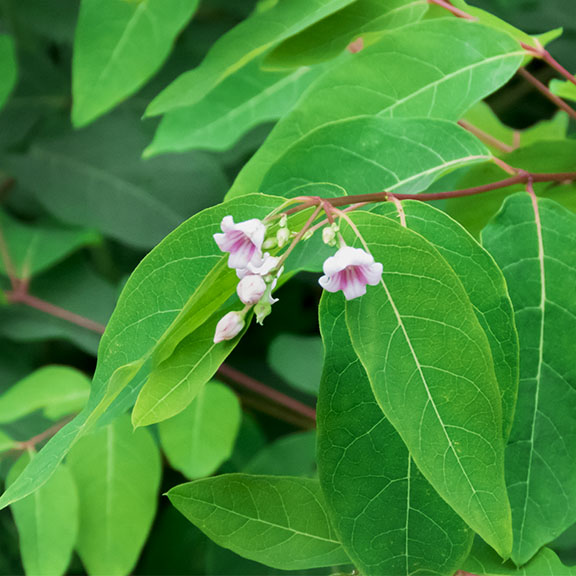
Spreading Dogbane is a bushy plant up to four feet tall. It reproduces vegetatively (by rhizomes) and by seed. The stems are smooth, light green to red. They are often more horizontal than erect, giving the plant a rather lanky appearance. The stems and leaves exude a milky fluid when broken.
Spreading Dogbane's green to blue-green leaves are 1½ to 4 inches long and up to 2 inches wide.
- The oval leaves are smooth, meaning that they don't have any teeth on the edges.
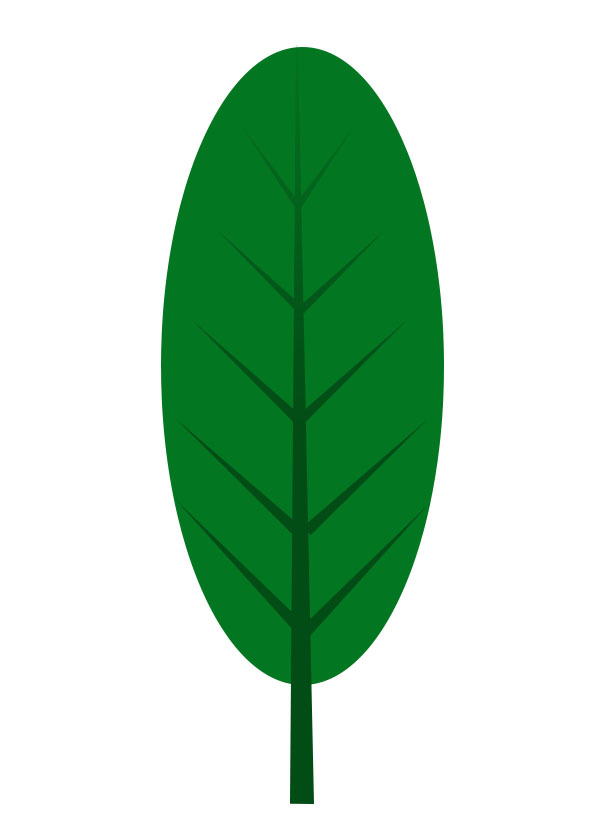 Smooth leaf edges do not have any teeth.
Smooth leaf edges do not have any teeth. - The leaves have bluntly-pointed tips, a rounded base, and a short leaf stalk.
.jpg) Leafstalk - the slender stem that supports the blade of a leaf.
Leafstalk - the slender stem that supports the blade of a leaf. - The leaves are arranged on the stem in pairs, oppositeone another.
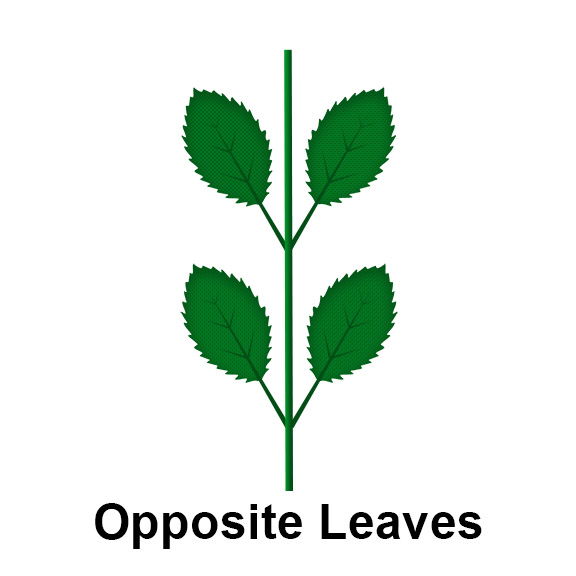 Opposite leaves - Leaves occurring in pairs at a node, with one leaf on either side of the stem.
Opposite leaves - Leaves occurring in pairs at a node, with one leaf on either side of the stem. - The main vein and secondary
veinsare somewhat prominent.
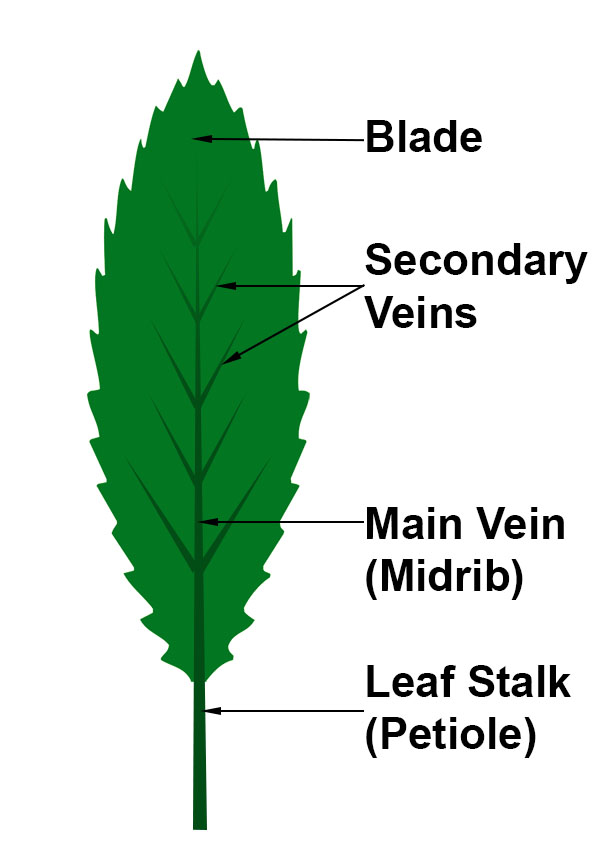 Vein - a vessel that conducts nutrients, sugars, and other substances throughout plant tissues; usually associated with leaves. The arrangement of veins in a leaf is called the venation pattern.
Vein - a vessel that conducts nutrients, sugars, and other substances throughout plant tissues; usually associated with leaves. The arrangement of veins in a leaf is called the venation pattern. - The foliage of Spreading Dogbane turns bright yellow in the autumn.
The flowers of Spreading Dogbane are fragrant and bloom at the end of branches in loose clusters.
- The individual flowers are loosely stalked. They are small (just over ¼ inch wide) and white or pale pink with darker pink stripes on the inside.
- The petals are recurving at the tips, and the flowers are generally nodding. In the inside center of each bell-shaped flower are five stamenswhich form a cone over the merged
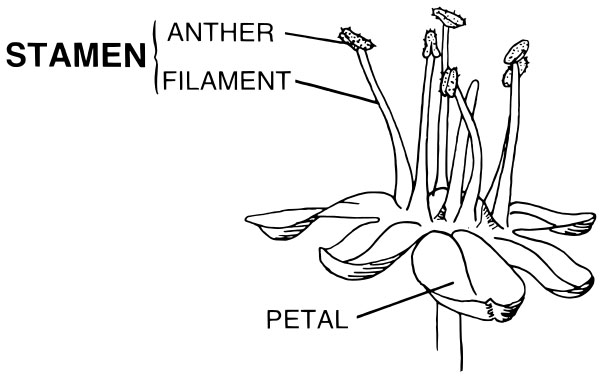 The male part of the flower, made up of the filament and anther.stigmaof the pistils.
The male part of the flower, made up of the filament and anther.stigmaof the pistils.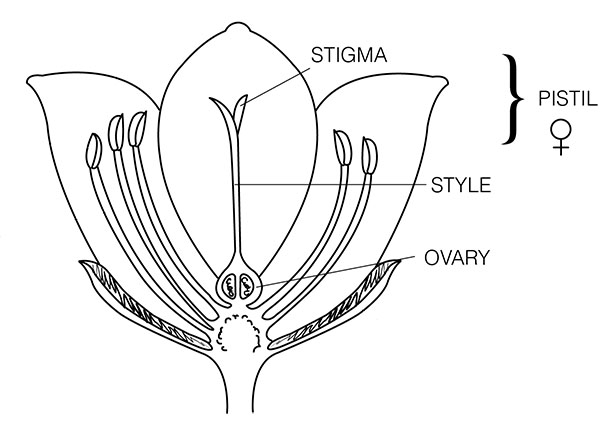 Stigma: part of the pistil, which is the seed-producing, or female, unit of a flower. The stigma is the tip of the pistil, where the pollen lands.
Stigma: part of the pistil, which is the seed-producing, or female, unit of a flower. The stigma is the tip of the pistil, where the pollen lands.
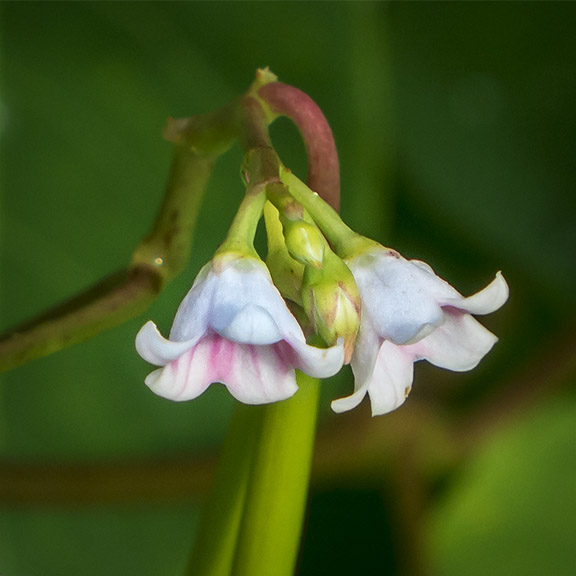
The shape and color of Spreading Dogbane's flowers provide keys to identifying it and distinguishing it from its close relative, Indian Hemp (Apocynum cannabinum). Indian Hemp, which is also found in many counties within the Adirondack Park Blue Line, has white, green-white, or yellow petals which are not recurving at the tips; and its flowers are upright instead of nodding.
In the Adirondack Park, Spreading Dogbane can be found in bloom from mid-June through about mid-August. A tally of flowering dates for the upland Adirondack areas compiled by Michael Kudish, based on data collected from the early seventies to the early nineties, lists Spreading Dogbane as in flower from 19 June through 18 August.
The fruit of Spreading Dogbane consists of long, slender pods about two to 6 inches long, ripening from green to a dull red. Seed pods are produced in pairs. The pods release small seeds tipped by a tuft of cottony hairs. The latter help to disperse the seeds on the wind.
Uses of Spreading Dogbane
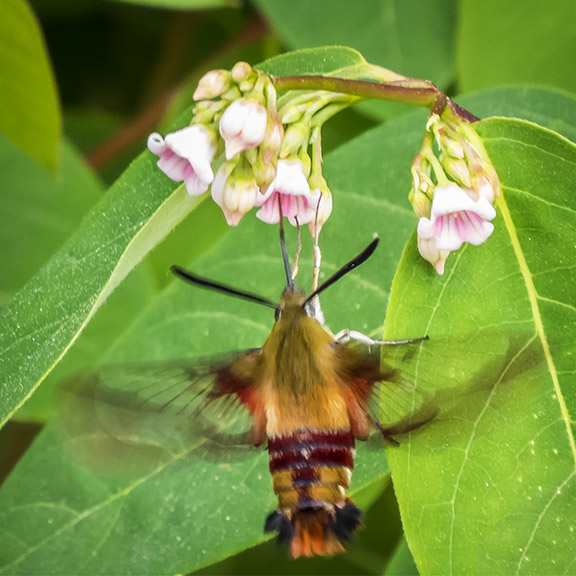
No edible uses are known. All parts of the plant are said to be poisonous to dogs, humans, livestock, and other mammals. The sap that emerges when you break a stem or leaf of Spreading Dogbane contains cardiac glycosides that are toxic to humans. Spreading Dogbane roots contain cymarin, a powerful cardiac stimulant.
North American natives, however, reportedly employed Spreading Dogbane to treat a wide variety of complaints.
- The Chippewa, for instance, used a decoction of the root for heart palpitations.
- The Iroquois took a compound infusion of the roots for stomach cramps.
- The Potawatomi reportedly used the root as a diuretic and a decoction of green berries as a kidney medicine.
In addition, the women of some native American tribes used dogbane stem fibers (best harvested in the fall) to make fine thread, used for sewing and for making twine, nets, fabric, and bowstrings. The Bella Coola dried and pounded the stems to make twine and fishing nets.
Wildlife Value of Spreading Dogbane
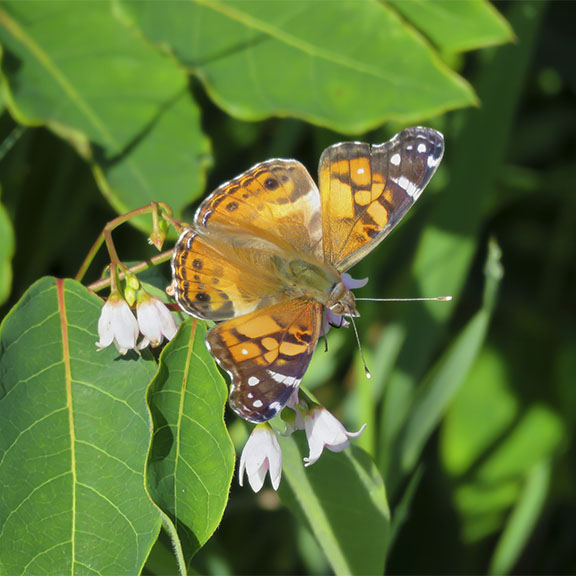
In the Adirondacks, Spreading Dogbane has virtually no importance as a food source for mammals. However, it is reported to account for a small portion of the diet of elk and Rocky Mountain goats in the western part of the US.
Spreading Dogbane is an important food source for certain insects. Bees, wasps, flies, and butterflies consume its nectar. Examples of butterflies that nectar on Spreading Dogbane include the Monarch, American Lady, Spring Azure, Great Spangled Fritillary, Common Buckeye, Silvery Checkerspot, Northern Crescent, and Pearl Crescent. The Hummingbird Clearwing moth is also a frequent visitor to Spreading Dogbane blossoms.
Spreading Dogbane (with its close relative Indian Hemp) is the larval host for the Dogbane Leaf Beetle (Chrysochus auratus). These iridescent blue-green insects live and feed mainly on these plants, laying their eggs on the leaves and stems and spending their adult lives feeding on the leaves. Dogbane Beetles apparently have developed adaptations allowing them to ingest and sequester the toxins in Spreading Dogbane's leaves.
Distribution of Spreading Dogbane
Spreading Dogbane is widely distributed on the North American continent. It is found in every US state except Hawaii, Kansas, and the southeastern states of Louisiana, Mississippi, Florida, and South Carolina. Spreading Dogbane occurs in most counties in New York State and all counties within the Adirondack Park Blue Line.
Habitat of Spreading Dogbane
This wildflower prefers full sun or light shade and can tolerate mesic to dry conditions. It apparently does best on relatively well-drained soils.
Spreading Dogbane is found in a variety of habitats. Its preferred habitats in New York State include roadsides, disturbed areas, fields, thickets, woodland borders, and other open areas. In the Adirondack Mountains, it is a common pioneer species after disturbances. After fires, Spreading Dogbane can recolonize burned sites through its rhizomes.
Spreading Dogbane may be observed on many of the trails highlighted here, including the Bloomingdale Bog Trail, Adirondack Loj Road, Lake Colby Railroad Tracks, and the field and roadside areas at Heaven Hill and John Brown Farm. It can also be seen at the Paul Smith's College VIC along several trails, such as the Barnum Brook Trail. Spreading Dogbane also grows profusely near the VIC building.
References
Michael Kudish. Adirondack Upland Flora: An Ecological Perspective (The Chauncy Press, 1992), p. 179.
Michael Kudish. Paul Smiths Flora II: Additional Vascular Plants; Bryophytes (Mosses and Liverworts); Soils and Vegetation; Local Forest History (Paul Smith's College, 1981), pp. 104-105.
New York Flora Association. New York Flora Atlas. Spreading Dogbane. Apocynum androsaemifolium L. Retrieved 27 November 2017.
Integrated Taxonomic Information System. Apocynum androsaemifolium L. Retrieved 19 November 2017.
United States Department of Agriculture. The Plants Database. Spreading Dogbane. Apocynum androsaemifolium L. Retrieved 27 November 2017.
United States Department of Agriculture. Fire Effects Information System (FEIS). Species Reviews. Apocynum androsaemifolium. Retrieved 27 November 2017.
United States Department of Agriculture. Forest Service. Plant of the Week. Spreading Dogbane (Apocynum androsaemifolium). Retrieved 27 November 2017.
NatureServe Explorer. Online Encyclopedia of Life. Spreading Dogbane. Apocynum androsaemifolium - L. Retrieved 27 November 2017.
Native Plant Trust. Go Botany. Spreading Dogbane. Apocynum androsaemifolium L. Retrieved 19 June 2021.
New York State. Department of Environmental Conservation. New York Natural Heritage Program. Ecological Communities of New York State. Second Edition (March 2014), p. 89. Retrieved 17 October 2015.
New York Natural Heritage Program. 2021. Online Conservation Guide for Riverside Ice Meadow. Retrieved 19 June 2021.
New York Natural Heritage Program. 2021. Online Conservation Guide for Pitch Pine-Scrub Oak Barrens. Retrieved 19 June 2021.
New York Natural Heritage Program. 2021. Online Conservation Guide for Cobble Shore. Retrieved 19 June 2021.
New York State. Adirondack Park Agency. Preliminary List of Species Native Within the Adirondack Park Listed Alphabetically by Scientific Name and Sorted by Habit. Volume 1. Updated 10.23.2006, p. 15. Retrieved 26 January 2017.
Connecticut Botanical Society. Spreading Dogbane. Apocynum androsaemifolium L. Retrieved 27 November 2017.
University of Wisconsin. Flora of Wisconsin. Apocynum androsaemifolium L. Retrieved 27 November 2017.
Minnesota Wildflowers. Apocynum androsaemifolium (Spreading Dogbane). Retrieved 27 November 2017.
Illinois Wildflowers. Spreading Dogbane. Apocynum androsaemifolium.
Retrieved 27 November 2017.
Eloise Butler Wildflower Garden. The Friends of the Wild Flower Garden. Spreading Dogbane. Retrieved 27 November 2017.
Lady Bird Johnson Wildflower Center. Apocynum androsaemifolium. Retrieved 27 November 2017.
Online Encyclopedia of Life. Flytrap Dogbane. Apocynum androsaemifolium. Retrieved 27 November 2017.
iNaturalist. Spreading Dogbane. Apocynum androsaemifolium. Retrieved 19 June 2021.
iNaturalist. Adirondack Park Observations. Spreading Dogbane. Apocynum androsaemifolium. Retrieved 19 June 2021.
Roger Tory Peterson and Margaret McKenny. A Field Guide to Wildflowers. Northeastern and North-central North America (Houghton Mifflin Company, 1968), pp. 292-293.
Doug Ladd. North Woods Wildflowers (Falcon Publishing, 2001), p. 68.
Lawrence Newcomb. Newcomb's Wildflower Guide (Little Brown and Company, 1977), pp. 250-251.
David M. Brandenburg. Field Guide to Wildflowers of North America (Sterling Publishing Company, Inc., 2010), p. 71.
Timothy Coffey. The History and Folklore of North American Wildflowers (FactsOnFile, 1993), pp. 171-172.
Wilbur H. Duncan and Marion B. Duncan. Wildflowers of the Eastern United States (The University of Georgia Press, 1999), p. 67, Plate 245.
National Audubon Society. Field Guide to North American Wildflowers. Eastern Region. (Alfred A. Knopf, 2001), pp. 346-347, Plate 514.
William K. Chapman et al., Wildflowers of New York in Color (Syracuse University Press, 1998), pp. 58-59.
Gary Wade et al. Vascular Plant Species of the Forest Ecology Research and Demonstration Area, Paul Smiths, New York. USDA Forest Service. Research Note NE-380, p. 4. Retrieved 22 January 2017.
John Eastman. The Book of Forest and Thicket: Trees, Shrubs, and Wildflowers of Eastern North America (Stackpole Books, 1992), pp. 68-69.
Plants for a Future. Apocynum androsaemifolium – L. Retrieved 27 November 2017.
Steven Foster and James A. Duke. Medicinal Plants and Herbs of Eastern and Central North America (Houghton Mifflin Harcourt, 2014), p. 172.
Lee Allen Peterson. A Field Guide to Edible Wild Plants. Eastern and Central North America (Houghton Mifflin Company, 1977), pp. 110-111.
Thomas S. Elias and Peter A. Dykeman. Edible Wild Plants. A North American Field Guide to over 200 Natural Foods (Sterling Publishing, 1982), p. 267.
University of Michigan. Native American Ethnobotany. A Database of Foods, Drugs, Dyes and Fibers of Native American Peoples, Derived from Plants. Spreading Dogbane. Apocynum androsaemifolium L. Retrieved 27 November 2017.
The Cornell Lab of Ornithology. Birds of North America. Subscription web site. Indigo Bunting. Retrieved 27 November 2017.
Butterflies and Moths of North America. Monarch. Danaus plexippus. Retrieved 27 November 2017.
Butterflies and Moths of North America. American Lady. Vanessa virginiensis. Retrieved 27 November 2017.
Butterflies and Moths of North America. Spring Azure. Celastrina ladon. Retrieved 27 November 2017.
Butterflies and Moths of North America. Great Spangled Fritillary. Speyeria Cybele. Retrieved 27 November 2017.
Butterflies and Moths of North America. Hummingbird Clearwing. Hemaris thysbe. Retrieved 27 November 2017.
Butterflies and Moths of North America. Common Buckeye. Junonia coenia. Retrieved 27 November 2017.
Butterflies and Moths of North America. Silvery Checkerspot. Chlosyne nycteis. Retrieved 27 November 2017.
Butterflies and Moths of North America. Northern Crescent. Phyciodes cocyta. Retrieved 27 November 2017.
Butterflies and Moths of North America. Pearl Crescent. Phyciodes tharos. Retrieved 27 November 2017.
Iowa State University. BugGuide. Chrysochus auratus. Dogbane Beetle. Retrieved 27 November 2017.
Charles H. Peck. Plants of North Elba. (Bulletin of the New York State Museum, Volume 6, Number 28, June 1899), p. 115. Retrieved 22 February 2017.
Wildflowers of the Adirondack Park
